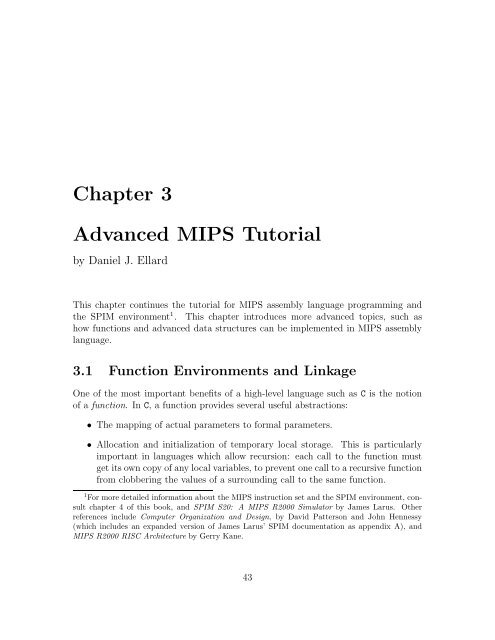MIPS Assembly Language Programming
MIPS Assembly Language Programming
MIPS Assembly Language Programming
Create successful ePaper yourself
Turn your PDF publications into a flip-book with our unique Google optimized e-Paper software.
Chapter 3<br />
Advanced <strong>MIPS</strong> Tutorial<br />
by Daniel J. Ellard<br />
This chapter continues the tutorial for <strong>MIPS</strong> assembly language programming and<br />
the SPIM environment 1 . This chapter introduces more advanced topics, such as<br />
how functions and advanced data structures can be implemented in <strong>MIPS</strong> assembly<br />
language.<br />
3.1 Function Environments and Linkage<br />
One of the most important benefits of a high-level language such as C is the notion<br />
of a function. In C, a function provides several useful abstractions:<br />
• The mapping of actual parameters to formal parameters.<br />
• Allocation and initialization of temporary local storage. This is particularly<br />
important in languages which allow recursion: each call to the function must<br />
get its own copy of any local variables, to prevent one call to a recursive function<br />
from clobbering the values of a surrounding call to the same function.<br />
1 For more detailed information about the <strong>MIPS</strong> instruction set and the SPIM environment, consult<br />
chapter 4 of this book, and SPIM S20: A <strong>MIPS</strong> R2000 Simulator by James Larus. Other<br />
references include Computer Organization and Design, by David Patterson and John Hennessy<br />
(which includes an expanded version of James Larus’ SPIM documentation as appendix A), and<br />
<strong>MIPS</strong> R2000 RISC Architecture by Gerry Kane.<br />
43

















